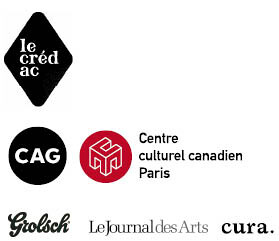The Blue One Comes in Black
September 9–December 18, 2016
1 Place Georges Gosnat
La Manufacture des Œillets
94200 Ivry-sur-Seine
France
Hours: Wednesday–Friday 2–6pm,
Saturday–Sunday 2–7pm
T +33 1 49 60 25 06
contact@credac.fr
Associate curators: Claire Le Restif and Nigel Prince, Director of Contemporary Art Gallery, Vancouver
Liz Magor (born in 1948; lives and works in Vancouver) is a major artist on the contemporary Canadian art scene. She represented Canada at the 1984 Venice Biennale and was the subject of a retrospective at the Museum of Contemporary Art of Montreal in 2016 (Kunstverein in Hamburg and Migros Museum Zurich in 2017).
Magor draws her ideas from beliefs, reactions, and human behavior, especially when they have something to do with the material world. She is interested in the social and emotional lives of ordinary, even domestic objects, being especially fond of materials that have lost the luster of their former use or function. Selecting them for their capacity to contain and reflect stories, like personal and collective identities, Magor reveals a resonance that goes beyond their mere utilitarian function through transformations and shifts.
Her works, she says, are designed, created and polished through a play of contradictions and seem to restore the antagonisms that both torment and partake of the vitality of existence. Magor tips us off, as it were, by working from hyperrealist casts of daily objects and articles of clothing, and stitching back up and conserving objects chosen for their manifest obsolescence. Through this awakening of an anonymous material world, we can read a certain history of our modern culture, from property to the need to protect and accumulate, as well as the ambiguity and inconstancy of the desire that connects us with objects.
The series of photographs called Karl’s Castle (2003) depicts a tourist site on Cortes Island (north of Vancouver), where the artist has a home. The interior depicted in the photographs was constructed by a Hungarian wrestling champion, mainly with recycled furniture, which lends a strange medieval atmosphere. Despite the vulnerable aspect of living alone, the artist shows that it is possible to live differently by searching for greater material autonomy and an escape that possesses a utopian character. The photographs highlight the creativity of these constructions made from recycled debris, underscoring the instinct that drives us to truly occupy our living space in order to feel protected there.
There is another series devoted to covers, which drape down from hangers like great swaths of color. Folded and ironed, they still bear the protective plastic bags from when they were last at the dry cleaner’s. Magor carefully selected them in second-hand shops, had them cleaned and then darned them with thread or polymerized gypsum as if to emphasize the preciousness of their threadbare condition and the intensity of the connection that links them still to their owners (cigarette burns, snags in the fabric, wear and tear…). The outdated labels they sport continue to proclaim the quality of their wool or their mothproofing. Their use seems to be closely bound up with Canadian national identity, either because they conjure up the length and rigor of winters in North America, or because the motifs they display recall the history of the Hudson’s Bay Company, one of the oldest companies, specialized in business and the fur trade since the 17th century.
The artwork itself is an unstable material that is liable to change and often filled with or steeped in things that have already had an erratic past.
All the Names II, III (2014) is one of the artist’s many pieces in which forms are encapsulated in silicon envelopes. This series of translucent, slightly iridescent cases protect a content that is thus placed beyond our reach and rendered imperceptible. The cases were molded from cardboard boxes that were wrapped in brown paper and ready to send; their interiors, left empty, were filled with various selected objects and then hermetically resealed. One contains small packages wrapped in gift paper and ribbons as well as an additional quantity of paper; the other, books and papers probably found, perhaps left behind, abandoned. These kinds of things interest the artist since they indeed reflect a certain historical period yet are incomplete, outmoded and don’t attain the status of heritage items or even curiosities.
For The Blue One Comes in Black, Magor has brought together a recent group of sculptures and photographs, which allow the visitor to measure the formal extent of her approach, looking to stress the memory of what is human for an exhibition located in a former factory.
–Extract from the press release.
At the same time, an exhibition of Liz Magor is presented at Marcelle Alix gallery from September 9 to October 29, 2016; 4 rue Jouye-Rouve, Paris 20 / marcellealix.com
Book
Liz Magor, The Blue One Comes in Black
Texts: Céline Kopp, Liz Magor, Lisa Robertson and Jan Verwoert
Graphic design: Mathias Schweizer
Co-published by Triangle France and Mousse Publishing
22.5 x 31 cm; 170 p. + booklet; English / French; ISBN: 978-88-6749-170-4
Exhibition sponsors
This exhibition is a partnership between Contemporary Art Gallery, Vancouver (Canada) and Peep-Hole, Milan (Italy).
It has been supported by the Canadian Cultural Centre in Paris; Canada Council for the Arts International Touring Program, The Province of British Columbia through their Touring Initiative and BC Arts Council Touring Initiative Program.
Liz Magor is represented by galleries Susan Hobbs, Toronto; Catriona Jeffries, Vancouver; and Marcelle Alix, Paris.
Press contact: Léna Patier, lpatier.credac [at] ivry94.fr / T + 33 1 72 04 64 47
A member of the Tram and DCA network, Crédac enjoys the generous support of the City of Ivry-sur-Seine, the Regional Direction of Cultural Affairs for Île-de-France (Ministry of Culture and Communication), the General Council of Val-de-Marne, and the Regional Council of Île-de-France.



